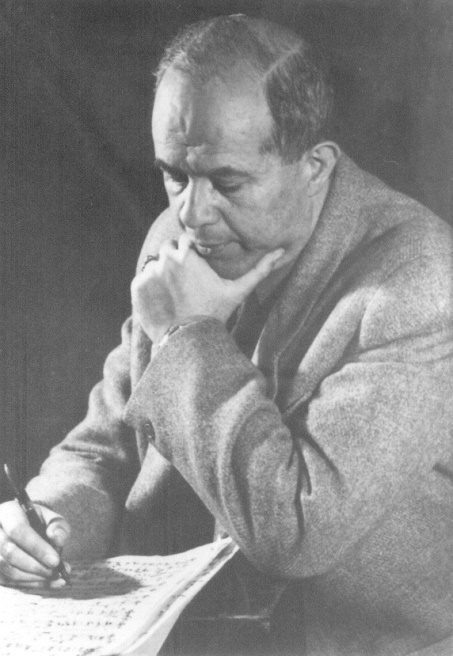
It was as late as the 1930s that Israeli art music established itself in the small Jewish community of British Mandate Palestine (Israel). Dan the Guard, the first “Hebrew opera”, premiered on February 17th 1945.[1] The opera was performed in front of the crowded hall of the Mugrabi Theater,[2] accompanied by “The Folk Eretz – Israeli Opera” Orchestra.[3] Marc Lavry set Dan the Guard to music between 1940 and 1943 and it was based on Shin Shalom’s play, Shots Fired Towards the Kibbutz, and arranged as an opera libretto by Max Brod.
The production of Dan the Guard was - considering the times - a great success: it was staged no fewer than 33 times. The opera describes everyday life in a Kibbutz during the years of the British Mandate. The protagonist, Dan, finds himself in a love triangle after one of the Kibbutz members begins courting his wife. Dan must also deal with the communal society of the Kibbutz and the opera as a whole depicts the different challenges and threats – from both within and without – that the Kibbutz was facing at that time.
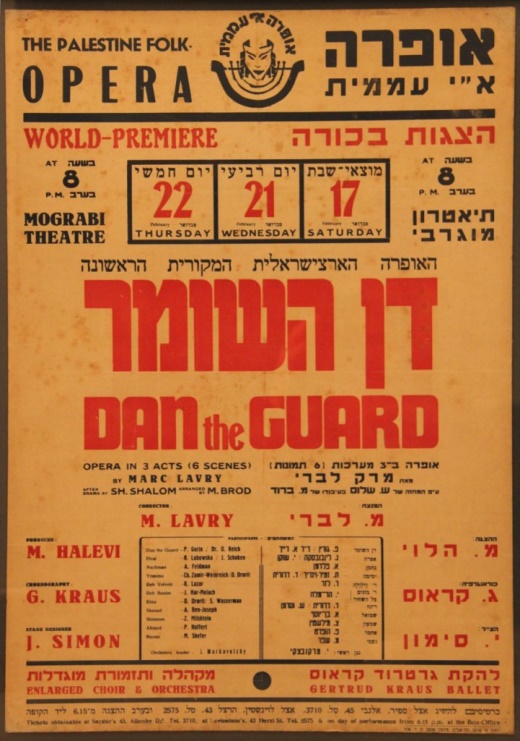
The opera’s reception was mainly positive, and stressed the originality of the piece: “Every artist attempts to rely on some folk national elements, deeply imbedded in the publics’ heart… Lavry did well in relying on them,”[5] wrote Moshe Bronzfat; “Lavry here created honest, ‘Kosher’ music – more power to him,” commented Gershon Swat.[6]
Dan the Guard’s unique standing stems from different factors, such as its affinity with national folk music and its relevance to the times: it is “one of a kind,” wrote Hirshberg.[7] It provides a unique musical expression, worked out with great care, to the different diasporas and cultures interconnected with the Jewish people, including Hassidic music, early Hebrew folk song, and even Arabic folk music. I will demonstrate and discuss some of these elements below.
Despite its musical and historical relevance, Dan the Guard remains largely unknown to the general public and even to opera-goers. With the exception of Yehuash Hirshberg’s article, current scholarship has hardly – if at all – discussed the piece.[8].
Moreover, Dan the Guard has not been staged in its entirety in a public concert since the 1940s: “If we were living in a [properly] developed country,” wrote journalist Yossi Shifman, “[t]his opera would have found its way on to our musical stages once every few years”[9] – but this has not been the case.
Still, Dan the Guard did receive some attention in a 2015 production, at the initiative of Dr. Gila. The production took place in the main hall of the National Library in Jerusalem.[10] and allowed for a much-needed re-evaluation and discussion of this work and its place in the repertoire of Israeli art music.[11]
Considering the scarcity of performances, it is not surprising that Dan the Guard remained largely forgotten in the archives. This paper is the first to offer a full discussion of the “First Hebrew Opera”. In the first section, I will explore Shin Shalom’s play, elaborating on the different ideological perspectives that led Shalom to write the play in times of confrontation with the local Arab population. Through this I will go on to explain the deeper meanings that lie in the opera. The second section will focus on the opera’s different musical connections: its affinity with the song “Hanita” [“What is at Night in Hanita”], and its integration of some core elements derived from Arabic folk music.
# 1
# Shin Shalom and "Shots fired towards the Kibbutz"
The libretto assumes a central role in almost every operatic piece, but it is of paramount importance in what is essentially a political as well as a personal play. As such it is important to have a closer look on Shalom: Born in Parczew, Poland, in the wake of World War I, Shalom’s family emigrated to Vienna. In 1922, the family decided again to emigrate - to Palestine (Israel). Shortly thereafter, they founded the “Kfar Chassidim” (village of the Orthodox), in the Zevulon Valley. Shalom was raised in a Jewish Orthodox family as part of a Chassidic dynasty (“court”) which was to some degree unusual in the sense that they had a more practical, down to earth, approach, and could be described as pioneering Zionists. Characters that are drawn on a similar model of Chassidic-Zionism may often be found in Shalom’s plays: in The Galilee Dairies (Yoman Ba’galil), for instance, Shalom describes such Chassidim plowing the land, with their long beards swaying in the wind.[12] Similar attributes are found in Shots Fired Towards the Kibbutz, specifically in the case of Rabbi Velvel’e (I will expand on this later).
Shalom wrote the play at the time of the 1936–39 “Arab revolt in Palestine” (The Great Revolt) and the narrative is set in the historical context of these events. On the front page, Shalom cites 1936 – the beginning of the revolt – as the year in which the play takes place. This was a tumultuous time, with increasing embitterment within the Jewish Community, especially in the wake of a surge of Arab attacks and the publication of the White Paper (1939).
The 1930s saw an influx of immigrants who were escaping the rise of nationalism in Europe, and many of them wanted to settle in the rural and historic upper Galilee. On March 21st, 1938, Kibbutz Hanita was founded and Arab attacks on the Kibbutz started the very same night. These attacks were widely covered by the local press. It is against this backdrop of events that Shots Fired Towards the Kibbutz was written.
Once Shalom had completed the play, he found it difficult to stage the work, especially in those years of strife. In 1938, Max Brod immigrated to Palestine (Israel) and soon struck up a close friendship with Shalom and decided to come to his aid. In 1940, Brod offered the play to composer Marc Lavry as an opera libretto. Lavry accepted the offer and so it was that, after much effort and a great many logistical problems, the play was finally brought to the stage as an opera, with the title Dan the Guard.[13]
# The Narrative of "Shots Fired Towards the Kibbutz"
The play takes place in 1936, on a Kibbutz situated in the northern part of Galilee.[14] The protagonist, Dan, is plagued by what can be described as a foreboding determinist sensation. He believes that he is haunted by what he refers to as “the Shadow,” which threatens both his mental and physical well-being. Nachman, one of the Kibbutz members, courts Dan’s newly wedded wife Efrat and tries to win her over. In the meantime, tensions rise in the Kibbutz as Ahmed, a neighboring Arab resident, arrives to warn them of a planned attack from the Arab villages.
The play takes place in 1936, on a Kibbutz situated in the northern part of Galilee.
Inner quarrels erupt in the Kibbutz, and Rabbi Velvele’ protests the fact that the members do not wear the Jewish head cover, the yarmulke, and that they do not guard the Sabbath. He chooses to sacrifice himself, and to atone in death for the sins of the Kibbutz members. During the attack on the Kibbutz, a stray bullet kills Rabbi Velvele’ and thus fulfills his prophecy.
In the third act, during the Arab attack, Nachman goes out to call for help and Dan, who is standing watch, sees him emerging from the dark, making his way back to the Kibbutz. He is flooded with emotions of repressed hatred and anger toward Nachman and, under the persistent encouragement of the Shadow, considers pulling the trigger and claiming, in his defense, that he did not recognize Nachman in the dark. Dan has a last-minute change of heart and, instead of shooting Nachman, he points his rifle toward the Shadow that haunts him. The play ends with the Kibbutz fending off the attack, Dan is reconciled with Nachman, and the Kibbutz is reunited.[15]
# Dan the Guard and Martin Buber: The Dialectic of Mutuality and the I-Thou Affinities
Shalom’s play is challenging. However, in my opinion, the key to understanding it lies in the protagonist’s idée fixe: several times in the play, Dan insists “I or him; I or you.”[16] This becomes a sort of a personal motto that almost defines him.
In 1923, the Jewish-Viennese philosopher Martin Buber published what would become his most influential work. In I and Thou (Ich und Du), Buber describes his dialectic philosophy, making a case for the command to love thy neighbor and for mutual responsibility. The affinities between Buber’s philosophy of I-Thou and Dan’s I or you are apparent. However, Buber’s philosophy is negated in the play by the forces that threaten Dan, and so it becomes “I [me] or him” and not “I [me] and him” or “I [me] – you”. It is this very negation of the concept that threatens Dan and the Kibbutz.
Buber was one of a number of influences on Shalom, and was well known within the circle of German Expressionist writers who influenced Shalom in his early years in Vienna.[17] Moreover, Buber was a highly influential figure for Eastern European Jews. In this context, “Hashomer Hatzair” is an important example that serves to explain Shalom’s background. “Hashomer Hatzair” propagated a socialist ideology of a communal society; as Yael Weiler writes, they were highly influential in Eastern European Jewish communities:
Their acceptance of the Eastern European Chassidic movement was personal, familial, and communal and influenced by the writings and lectures of Martin Buber, who cultivated values derived from the sphere of the Chassidim and stressed the concept of an Organic society, and a non-barrier community between one person and the other.[18]
Shalom, who was educated as an Orthodox Jew in Poland, absorbed these ideals from an early age. Buber’s zeal for communal societies and his support for the concept of the Kibbutz and communal living made him one of the main advocates for the Kibbutzim. Buber’s ideology explains a lot about Shalom’s own ideology in Shots Fired Towards the Kibbutz.
Lipsker describes the unique synthesis between religious zeal and revolutionary drive that produced the aim for a socialist community for Eastern European Jews. Such ideals were central for Shalom’s Yablonska Hassidic “court.” As I have mentioned, this court was unusual in that its members were Orthodox and also Zionists who did not refrain from manual labor and agriculture.[19]
# 2
# Dan the Guard, the Opera
It is the music of Dan the Guard that in many ways explains and decodes some of the major philosophical ideas with which Shalom infused his play Shots Fired Towards the Kibbutz (the original title).[20] The concept of mutual responsibility, which I discussed in the first part of this paper, played an important role in defining the attributes of this opera: the same philosophical ideas are also expressed in the musical aspects that Lavry chose to incorporate.
So when Dan proclaims his own idée fixe – “him or me” – which encapsulates the concept of mutuality, he is assigned with a leitmotif.[21]
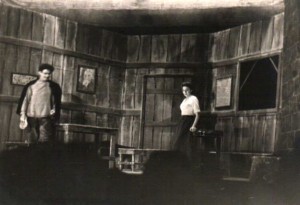
The leitmotif is constructed mainly on the interval of the major or minor seventh. The specific choice of the seventh, to represent the concept of “Me or You,” “Him or Me,” is unusual in the present context. Lavry’s harmonic-melodic language usually avoids such “bold” intervals – the major seventh in particular has a dissonant ring to it. By relying on these intervals, Lavry was portraying musically the deterministic crisis in Dan’s philosophy of “Me or You” and the forces that threaten him.
So, for instance, Dan proclaims to Efrat: “Soon it will be decided: Him or Me, Him or Me.”[22] In examples 1 and 2 below, the appearance of these sevenths is made very clear.
So, for instance, Dan proclaims to Efrat: “Soon it will be decided: Him or Me, Him or Me.”
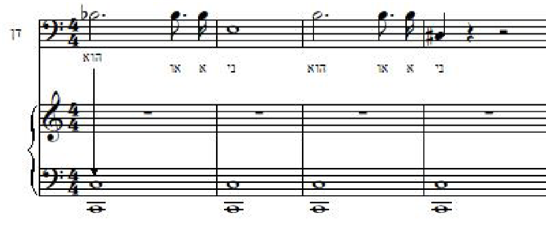

As can be seen in the example above, Lavry attributes a specific motif to “Him or me,” a fact that testifies to his sense of the significance of this expression. It is possible that he might have done this under the advice of Shin Shalom and Brod, both of whom were friends of Lavry.[23]
# Me or Him? A Shadow Play
It is clear that the concept of mutuality that recurs throughout the play largely appears by way of its negation – hence: “Me or Him!” The origin of this negation, and the forces that threaten the Kibbutz, are channeled and portrayed by “the Shadow.” In many ways, the Shadow is an axis on which the entire play revolves. For example, at the beginning of the play, Dan walks in on a conversation between Efrat and Nachman: “Again, I found him not, again – Unseen, Unheard, but he will arrive soon, I know that soon it will be determined, Him or me, Him or Me!”[24] On the face of things, it appears that Dan is inadvertently relating to his wife’s suitor, Nachman. But upon closer reading, it becomes apparent that Dan is referring to the Shadow: “Near the watchtower, I stand tonight – and I know that something will happen tonight, for I have seen him in my dreams, I have seen him today… close, close – the black shadow. Me or him, Me or Him. One of us must fall.”[25]
Later during the play, Shalom also “allows” his protagonist to explain: “Shadows… Shadow…, the diaspora is a shadow. And that shadow has been ruling our lives for two thousand years. Mutual hatred is a shadow [my emphasis] – and it has been weighing over man since man began… do not despise the shadows brother…”[26]
Shalom presents the Shadow as a modern-day Mephisto, a manifestation of selfishness who reveals the negative attributes of human nature, of “false hatred” [“sinat Hinam”]. The Shadow epitomizes the negation of mutual responsibility, and in many ways this is the nefarious germ of those forces that threaten both the individual and the Kibbutz community. The amorphic nature of the Shadow serves to reveal how superfluous he is. Once Dan literally “disposes” of the Shadow, he “redeems” the Kibbutz: he is at once united with the Kibbutz and it with him. He also attains a higher cause – one that goes beyond the “earthly” triviality of the relationship between Efrat and Nachman.
Moreover, a closer look at Lavry’s composition reveals that Dan and the Shadow are dangerously close: so, while the Shadow only makes an appearance at the end of the play, musically speaking, Lavry removes his mask at a much earlier stage. In Duet 33, bars 6–8, 77–80 (see Example 3), the leitmotif of “Him or me” appears in the seventh, and it appears earlier, mainly in Recitative 6 and Aria 7. It is a motif that represents Dan’s moment of crisis, as he insists that it is “Him or me” (except that now it is actually the Shadow). The leitmotif in the seventh is the Shadow’s motif; Lavry is indicating his presence. And so, only at the end of the opera is it made clear that the threat looming over Dan was the Shadow.
Moreover, a closer look at Lavry’s composition reveals that Dan and the Shadow are dangerously close: so, while the Shadow only makes an appearance at the end of the play, musically speaking, Lavry removes his mask at a much earlier stage.
![Example 3: Dan and the Shadow, Duet 33: Leitmotif “Him or Me? Large Seventh, Bars 77–100] (https://media.graphcms.com/Bn4TKWyiSViP3r1aVHK6)
The Shadow is in many ways a non-entity, a Doppelgänger cynically mimicking others. Note the loose imitative gesture that Lavry creates between Dan and the Shadow: “I am the Universe, that is insane” exclaims Dan in Bars 6–10 and immediately after the Shadow cynically mimics Dan, musically and textually, with the same phrase: “I am the Universe, that is insane, deluded and insane”. This musical phrase also shows the use of the seventh leitmotif (see Example 4).
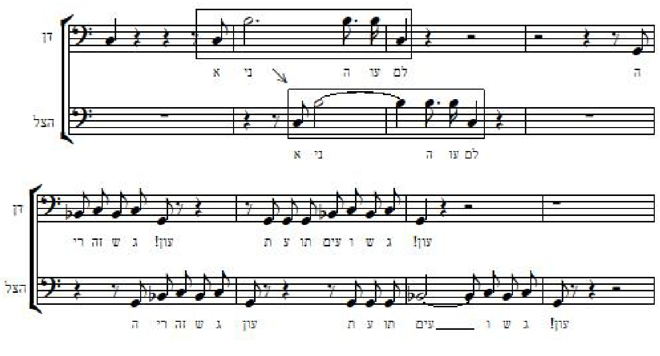
# Christian Allusions in Shots Fired Towards the Kibbutz: Aspects of Rabbi Velv’ele’s and Dan’s Characters.
There is no doubt that Dan is the play’s protagonist; however, Rabbi Velv’ele is attributed with almost equal importance in terms of the characters’ complexities. Shalom drew inspiration from a wide array of subjects, from the humanist to the theological. Some of these themes went well beyond Judaism and incorporated theological concepts derived from Christianity. Rabbi Velv’ele is an excellent example of this: there is a certain duality relating to both Christianity and Judaism in the way that his character might be interpreted. In relation to Judaism, Rabbi Velv’ele chooses to sacrifice himself to atone through death for the sins of the Kibbutz members, who do not cover their heads (with a yarmulke) or guard the Shabbat. Once the Arab gang’s attack starts, Velv’ele willingly and consciously puts himself in the line of fire and is killed by a stray bullet. In the early parts of the play, Velv’ele describes himself as part of the “Lamed Vav Tzadikim” (the 36 hidden righteous ones).[27] While on his death bed, he whispers: “thirty-six… this commandment has come to me and I will miss it?…”[28]
In Jewish mysticism it is often reasoned that the physical presence of one such pious man (out of the 36 righteous) allows for the existence of a certain place, and even for the entire world to stay in its place. The Biblical Lot, the righteous man in Sodom and Gomorrah, is a good example of this.
Shalom’s intention was to portray Velvel’e as one of those 36 righteous men. Some Hassidic courts believe in Etpashtuta de’Moshe bechul dara ve’Dara (Aramic), that is: “The appearance of Moses in every generation and generation,” as it appears in The Zohar book of Kabbalah. Rabbi Hannina Ben Dosa acquires a special place within this context of the 36 righteous men, as a miracle worker and a righteous man endowing a blessing in a certain place. The Talmud says: “A voice speaks from Mount Horeb and says: the entire world is fed for Hanina my Son, and Hanina my Son is satisfied with only some Carobs, from one Shabbat eve to another.”[29] Baal Shem Tov’s interpretation is well accepted: that it is through this heavenly path from Mount Sinai, created for Hanina, that abundance is provided to the World, and from it the World feeds.
By far the most significant example of sacrifice in Judaism is the binding of Isaac, which of course does not end in the actual sacrificing of Isaac. “Yom Kippur” (Day of Atonement), is another example of a redemptive narrative, though it is mainly redemptive of the individual.
The theme of an individual sacrificing himself in order to atone for others is mainly part of the theo-philosophy of Christianity: Jesus redeems mankind from the earliest sin of Adam and Eve and to the end of all times.
The theme of an individual sacrificing himself in order to atone for others is mainly part of the theo-philosophy of Christianity: Jesus redeems mankind from the earliest sin of Adam and Eve and to the end of all times.
To return to Rabbi Velvel’e, he insists: “I am the World, I carry its sin.[30] Shalom’s perspective on Rabbi Velve’le – the fact that is ascribed with flesh and blood and messianic, redemptive narratives – almost completely removes him from Judaism and accentuates the Christian allusions.[31]
Furthermore, Shalom also likens Velvel’e to Jewish historical figures known as false prophets: “Shabtai Tzvi? Frank? Those criminals, those heretics, those shoe – less, they are the ones who speak for a place”; “… Why not help them carry the wooden beam? Why shall we too, not carry the wrongs and sins, on which the world stands?”[32] Both Shabtai Tzvi and (Jacob) Frank are widely perceived as individuals who betrayed their heritage. But in Shlaom’s narrative, they redeem a certain “place” – a city, town, or indeed a Kibbutz. As such, they are, from Shlaom’s point of view, validated.
Netta Stahl and Tzvi Sadan explain[33] that the special interest that members of the Yishuv took in Jesus was shared by many of the Jewish-Israeli artists of the time. Sadan writes that: “Along with the full negation of Christianity in Judaism, at the time [19th and 20th centuries, LG], there were several artists who asked to re-examine the perspective on him [Jesus], and to accept some of his teachings about Judaism and Zionism.”[34] For instance, many perceived the oppression of Jesus by the Romans to be a metaphor for their oppression by the British mandate. For immigrants who arrived in Israel from mainly Christian countries, Jesus represented a sense of continuity with their religion. In “Der Meister,”[35] Max Brod describes the life of Jesus through the eyes of his sister. But the image of Jesus also appears in works by Uri Tzvi Greenberg, Shalom Ash, and Reuven Rubin, including several drawings such as “The Meeting” (Jesus and the Jew) from 1922.[36]
Taking a wider perspective on Shalom’s work, one can see that this theme of “Redemption,” or sacrifice, is not exclusive to this play. In Shabbat Ha’olam (1945), for example, Shalom’s protagonist is – as A.B. Yaffe explains – an individual facing sin and wrongdoings who in the end chooses, in an act of self-sacrifice, to die in flames.[37] The stylistic and semantic resemblances between the protagonist of Shabbat Ha’olam and Rabbi Velve’le are apparent. Actually, it is “[t]he Metamorphosis of this character,” writes Yaffe, that also appears in Dan the Guard. Although Yaffe does not mention redemptive narratives, he does write that: “A person walks towards his death, so that others might be awakened.”[38] But Yaffe sees the source of this narrative as a paradox in Shalom’s creative life: the need for individuality, on the one hand, and a desire for deeper assimilation, to become one with his fellow men, on the other.[39] Lipsker identifies the same set of themes in Shalom’s work and stresses the presence of two different themes: the “I” and the “Communal-Social.” Shalom was already preoccupied with these themes in his earlier works, which were written in Palestine (Israel) – they are more than present in the song cycle, In the Heart of the world (1926–1927), for instance.[40] But it is also possible that the source for this Christian influence is not Shalom himself, and here one must consider Max Brod.
# Max Brod and Shin Shalom: Following the Trail of Christianity
Brod had an explicit interest in Christianity and saw it as part of his own artistic tool kit. By 1921 he had already completed “Paganism, Christianity, Judaism,”[41] an extensive philosophical essay in which Brod shows how these theologies share many similarities. Much later, in 1956, Brod wrote a monograph on the life and work of the German humanist scholar Johannes Reuchlin,[42] one of the main founders of “Hebrewism.”
Shalom, for his part, was very much aware of Brod’s use of such ideas in his work. For example, Shalom mentions, with almost a sense of personal pride, that Brod heeded his advice when writing about Jesus’s life in “Der Meister” in the 1950s: “Out of full agreement with my warning, he was careful not to fail in the same Christian failings of Shalom Ash in his Christian Prose.” It is possible that the influence and role of Christianity in Jewish-Israeli literature was discussed among the two; if so, they certainly could have discussed it with reference to Dan the Guard.[43]
In other words, Christian ideas could have been transmitted to the text of Dan the Guard via Max Brod.
# Motivic Relationships in Dan the Guard: From the Folk to the Popular to the Artistic
Lavry constructed Dan the Guard on motivic ideas and themes from one of his earlier songs, “Ma Milayla BeHanita” (“What is at Night in Hanita”), using the words of Shin Shalom. As can be seen in what follows, Lavry develops and reintroduces thematic ideas from the song through the course of the opera, embedding them as leitmotifs to represent the main characters: Dan, Nachman, and Rabbi Velvel’e.
Shin Shalom integrated “Hanita” into the third act of his play, and likewise it forms part of the opera’s third act.
What is at night in Hanita?
In Hanita what is at night?
Darkness wherever I look,
Many killings in Israel…
Indeed, that all is lost, and now
Will we here be not redeemed
Lord you have known,
God you answer!
And no sign have you seen?
And no clue as to the redeemer?
There is a watch in Hanita
All night long all night
The integration of “What is at Night in Hanita” generates in the opera a wide array of associations with the specific epoch in which Shalom wrote the play. A sufficient understanding of the circumstances in which the song was written is therefore another key factor in understanding the opera.
Shalom wrote “What is at Night in Hanita” following the attacks on Kibbutz Hanita in March 1938. Kibbutz Hanita was established as part of the “Wall and Tower” settlements. On the very night in which the settlement was established, it was attacked by a local Arab mob and two members of the settlement who were on watch were killed. Later, a series of attacks ensued and eight of the new settlers were murdered. The attacks were widely reported in the daily press, mainly in Davar, where Shalom published several of his songs. He undoubtedly learned of those attacks through Davar, among other papers. It is hard to determine the exact date on which Shalom wrote his poem, “Hanita,” but it is clear that the poem was written shortly after the attack on the Kibbutz, and eventually found its way to Lavry. Once he read the poem, Lavry decided to arrange it as an acapella song. The circumstances through which the poem reached Lavry, and those in which he composed the song, are described by the composer himself in a recently discovered radio interview:
I remember that I once conducted the “folk opera.” It was in Haifa. An old man was visiting the performance – a known figure, Yitzchak Sade. He was from the heads of the “Hagana.” And after the performance, he told me: “You know Lavry, maybe we can take a small ride.” I think that was in 1937, or 1938. And we drove. It took more than several hours, and in the morning we reached a place that is not far from Hanita. It was then called “lower Hanita.” And there sat a few Boys. There was a plan to conquer the mountain and build something there. Because it was a very important point. So it happened and I could not leave – for there were shots. And after I had nothing to do, I started composing a song. The words to the song were given to me by the old Man – “Hanita”, by Shin Shalom. So I wrote in a very simple manner to one voice, because among the boys, there was one who was like an Eunuch. And the rest of the boys joined – there were some women too.[44]
Lavry mentions that the song was given to the head of the “Palmach,” Yitzchak Sade, and Sade gave the poem to Lavry. I believe that Sade, who was known as a very social person, was personally acquainted with Shalom, and that he handed the new poem to Lavry personally, a practice that was accepted in those days.
Lavry mentions that the song was given to the head of the “Palmach,” Yitzchak Sade, and Sade gave the poem to Lavry.
Over the years, the appearance “What is at Night in Hanita” in the third act of the opera turned it into a “hit” song among the members of the “Hashomer Ha’Tzai’r.” It might be reasoned that the song became more familiar following the performance of the Opera in 1945.[45] However, Shalom had already published the poem “Hanita” in 1940, in the third act of his play.
A closer look shows that the melodic theme of the song is integrated into the overture: the opening measures of the song (Bars 1–4, see Example 5) are copied and orchestrated as opening measures of the opera (Bars 1–6, see Example 6). A similar compositional technique appears earlier in the symphonic poem “Emek” (Valley, 1936), which is constructed around Lavry’s earlier song, “Emek” (text by Raphael Eliaz), composed only a short while after his emigration to Israel.[46] This was the modus operandi of Lavry’s composition. It might be assumed that he drew his inspiration from the work of Mahler, who similarly constructed larger works on the basis of his earlier songs.
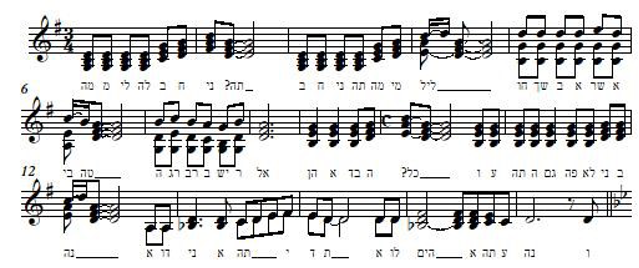
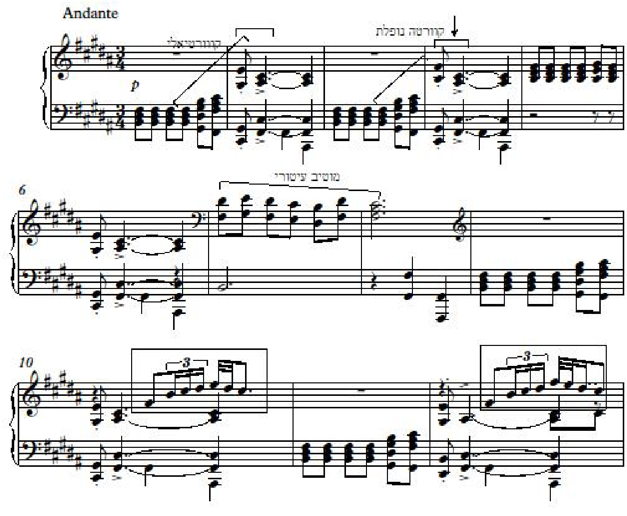
There is, however, a difference between Lavry’s and Mahler’s approaches: while the song that Lavry sets to Shalom’s poem is his own, it integrates a direct quotation from folk (Arabic) music.
This can be seen clearly if one looks at the ornament in bars 10–12. The specific circumstances by which this ornament was integrated into the song are explained by Lavry in that same radio interview from the 1960s:
And throughout the day we were singing, learning the song. I changed the song repeatedly. It is interesting that ahead of us were Arabs, and always when we were singing one phrase, and I was teaching them the melody – for example “There is a watch over Hanita,” then suddenly we hear from afar this kind of Arabic ornament [Lavry sings out the Ornament found in bars 10–12!, LG]. We got so used to it that we always took a break – it was like this game, but that game became very serious because it stayed in my composition. [Did you feel the need to leave it in your work?] Of course, the ornament exists to this day, in an organized manner with an instrument.[48]
A closer look at the first measures on the melodic line of “What is at Night in Hanita,” bars 1–2, reveals that they are constructed on the same skeletal notes of the ornament sung by village Arabs (the ornament is based on F#, b, C#, E and F#b, C#, F#, C#). It is a musical phrase that is repeated in different permutations throughout the opera, and which often describes Dan’s character (see below). Lavry testifies that he changed the song several times as he was learning it with the choir, so it might well be that he relied on the thematic outline of the ornament in the first phrase. It is hard to say how themes coagulated into the score but it is reasonable to assume that the Arabic theme that Lavry heard was not of the western equal temperament and that it found its way to the opera through Lavry’s tonal perspective.
The interesting thing is that, later in the opera, that same melodic line of the song “What is at Night in Hanita,” with all of its folkloristic connotations, becomes Dan’s leitmotif.[49] It is a leitmotif that appears in several permutations in the course of the opera. It should also be here mentioned that the song's theme and the leitmotif for "him or me" discussed earlier are not identical or correspond to each other.[50] And so, ironically, the theme that characterizes the protagonist of the first Hebrew Opera is derived from Arabic sources.
There are several important examples throughout the opera that identify this is a leitmotif: for example, in Aria 7a when Dan is trying to explain to Efrat the distress that he is in. Efrat appears indifferent and even doubts his sanity. For his part, Dan is trying to describe the depth of his despair in his Aria: “You should have stood like me in the Orchard.” In this Aria, Lavry attaches to Dan the main melodic phrase from the song “What is at Night in Hanita” (the fourth with which the song opens appears in the strings). Lavry integrated this theme into Dan’s character with the intention of associating him with the concept of the “Kibbutz” in general and Kibbutz Hanita - In particular the 1938 tragic attacks on Hanita that inspired Shalom to write the poem.

Late in that Aria, Dan describes to Efrat one of his philosophical principals – the sense of collective responsibility that he feels toward everything and everyone: “Every good deed that was done in the world, was done by me, and every evil deed that was done in the world I have done it, and all this asks, demands of me, calls to me – calls to me.”[51] Dan’s words reflect the sense of collective responsibility and communality of life in the Kibbutz; Lavry chose to combine the melodic line of the “Kibbutz” song (Hanita) with sounds from the strings as a leitmotif (Example 8).
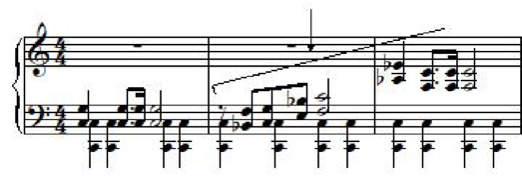
An important thematic metamorphosis of Dan’s leitmotif, which again is constructed around the song, appears in “Dan next to the tower,” an Aria that shows Dan in conversation with Nachman. As part of the mutual responsibility concept, Dan offers Nachman his heart for safekeeping if he is killed in the fighting. If we are to compare the theme of the song (see Example 5, bars 1–2), to the Aria “Dan next to the tower” (see Example 9, especially bars 77–81), it is clear that the rhythmic and harmonic values have metamorphosed. These are of course some of the characteristics of the leitmotif technique.
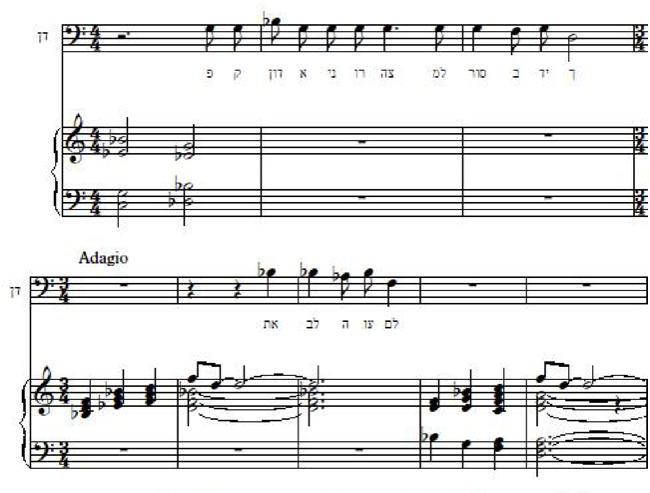
Still, it is important to stress that Lavry’s interest lay mainly in the interrelation between the song and the opera, and not so much in the affinities between folk music and the opera. I deduce this from Nachman’s character: in the following examples the reader can see the chronology of things and the direct transition of the thematic material from the song to the overture, and to Nachman’s character. Theoretically speaking, Lavry could have deployed further folk music in the opera, but instead he focuses on themes from the song. This is apparent in the second verse of the song: “And no sign have you seen? And no clue for the redeemer?”
Still, it is important to stress that Lavry’s interest lay mainly in the interrelation between the song and the opera, and not so much in the affinities between folk music and the opera.

This specific phrase becomes part of the overture in Bars 49–104, after going through rhythmic and melodic permutation. Right from the beginning of the phrase Lavry omits the anacrusis and relies on a drop of the 3rd from the central tone instead (Bar 49, piano reduction) of the major 2nd – G – F, that appears in the song. This allows Lavry to further develop the thematic cell by providing it with further fluency (Example 11). Lavry is relying on canonical and imitational textures – another device that allows him to further develop the narrow thematic cell of the song, which now sounds faster and more dynamic.
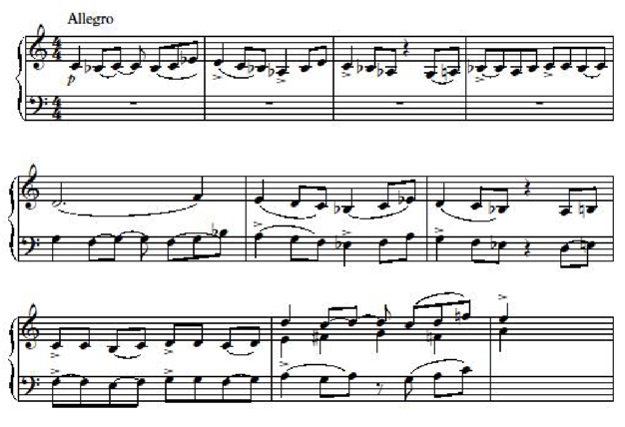
At the next stage in the opera, this phrase becomes Nachman’s leitmotif. It can be seen in “Nachman’s Aria”: “Not good Efrat, not good” (see Example 12). It might well be that the somewhat mysterious character of this phrase, which is mainly created by the reliance on 2nds, represents the danger that Nachman poses for the relationship between Dan and Efrat.

# Rabbi Velvel’e in the Opera
Earlier in this article I explained the multifaceted importance of Rabbi Velve’le in the opera and the play. Lavry provides a unique musical perspective on Velvel’e. He does this mainly by creating a dichotomy between Velvel’e and the rest of the Hassidim in the Kibbutz. One early scene is “Dance of the Hassidim” (beginning of Act 2), which mainly relies on the augmented 2nd that is so characteristic of Eastern European music. It is impossible to establish a connection between the “Dance of the Hassidim” and Velvel’e – despite the fact that he is described as an Orthodox Jew.
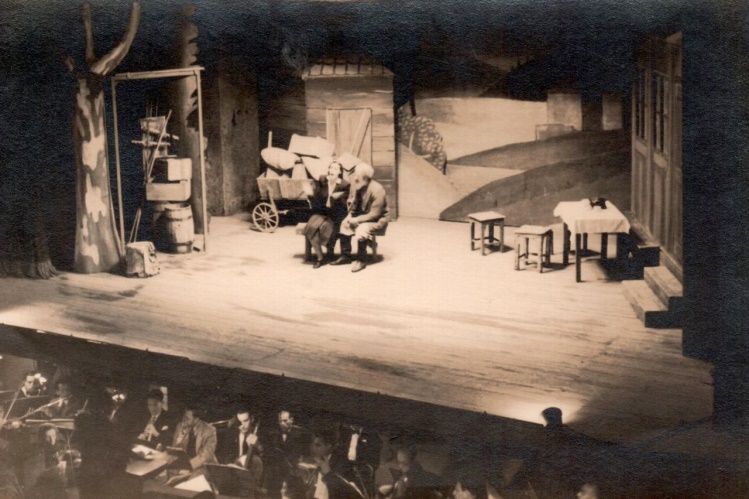
Rabbi Velvel’e’s melodic line is derived from the song “What is at Night in Hanita.” In other words, the song is not only the inspiration for Dan’s character but also for Rabbi Velvel’e, as can be seen in Example 13 (Aria no. 14).
At a later stage, Lavry further develops the song’s musical phrase by narrowing it to a three-note motif, with the interval of the 2nd and the 3rd derived from the song (see the following examples). Lavry thus distinguishes between Dan’s leitmotif and Velvel’e’s motif, which relies on a motivic development on the same phrase. See bars 1–2 in the song (starting from the third beat of bar 1), and the same intervals which appear in Aria 14: B, C#, E; E, F#, A (Example 13).

In Aria 15b (which appears in Example 14), Lavry establishes the motif that defines Velvel’e’s character by relying on permutations of a 2nd and a 3rd.

The fact that Lavry constructs Velvel’e with music and motivic cells derived from the song explains a lot about his character: while Rabbi Vevel’e is an Orthodox religious Jew, Lavry appears to connect him musically to life in the Kibbutz.
It is likely that this was not an arbitrary decision by the composer: Lavry had personal contact with Shalom, who had in many ways based Velvel’e’s character on his own. That is to say that Velvel’e is an Orthodox Jew but, at the same time, his Zionist attributes are apparent. So while his face is “covered in white beard and curled sidelocks,” he also “wears short sports pants.”[53]
Shalom describes Rabbi Velvel’e in a similar fashion to those Hassidic Jews that founded “Kfar Hassidim” – the same Hassidic court in the Zevulon Valley from which Shalom himself came. It is probably for this reason that Lavry associates Velvel’e musically with the Kibbutz. It is important to mention that Lavry does not associate Velvel’e with any essentially Christian musical symbols.
In other words, Dan, Nachman, and Rabbi Velvel’e are all constructed through motifs from the song. But this does not mean that all the characters in the opera are related to the same themes: both Efrat and Ahmed’s characters are musically linked to thematic materials derived from the Middle Eastern (or Israeli) musical style.
Efrat, for example, has two motifs, the first has rhythmic attributes (triads): see Recitative 4, Bars 1–12 and Aria 7, Bars 45–47 (Example 15a).
Efrat, for example, has two motifs, the first has rhythmic attributes (triads): see Recitative 4, Bars 1–12 and Aria 7, Bars 45–47 (Example 15a).

The second motif that characterizes Efrat and ties her to the locality of the Middle East is an ornamented Arabesque that appears after a leap of the 5th. Important examples are Aria 16a, and Arietta 5 (Examples 15b and 15c).


A similar kind of Arabesque to Efrat’s is attached to Ahmed’s character: an ornamented oriental phrase that can often be found in the Mediterranean music of the period (see Example 16).
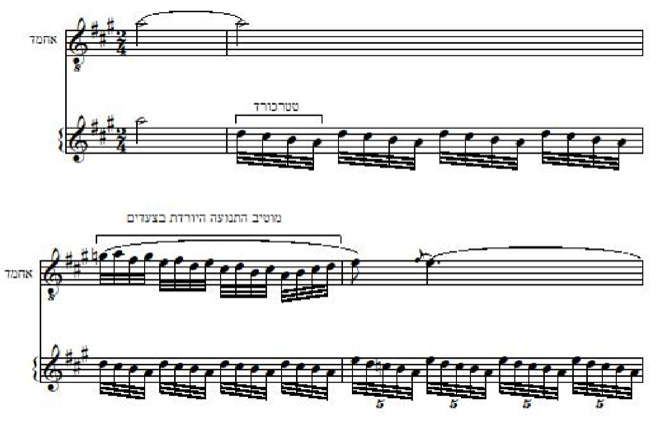
From Example 16 it is clear that those melodic elements derived from the song and relied on as motifs for the different characters were indeed important decisions made by the composer.
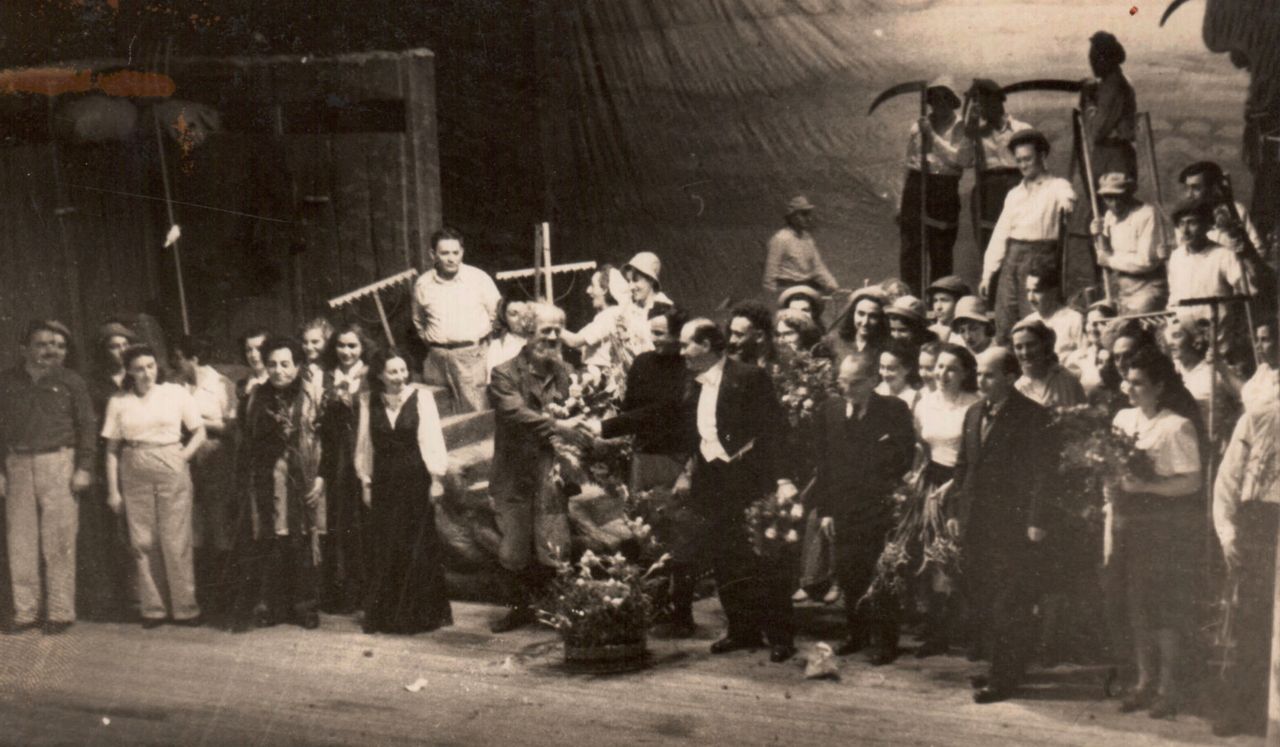
# Summary
Despite the fact that Lavry was one of the more important Israeli composers, his music is seldom heard or played. Equally, there has been little research on his music. It is clear that a wider study of Lavry’s opera music is required – one that would help us to understand the place of this opera within his oeuvre. A similar study is required into Lavry’s music more generally. Other pertinent questions that remain unanswered relate to Lavry’s evolution as a composer. How and when did he change his musical style – if at all?
Despite the fact that Lavry was one of the more important Israeli composers, his music is seldom heard or played.
The question of this opera’s relevance to our own times is an important one. In this context, the reader might bear in mind the heterogenic character of the opera: Hassidic dance, Italian music inspired by Puccini, and even Arab music all have important presences in this piece, as I have explained. This musical heterogeneity represents the unique pluralism in Palestine (Israel) in the Yishuv period, and in many ways, it is this pluralism that is unique to Israeli society today.
But still the nagging question remains: why was the first Hebrew opera forgotten? Musically speaking, Lavry’s compositional technique is not to be underestimated. It may very well be that it is the Zionist character of this piece, expressed in the Mediterranean or Israeli musical style of the period, that is perceived by some as nationalistic. However, Dan the Guard (much like Shalom’s play Shots Fired Towards the Kibbutz), is more a patriotic than a nationalistic work. The subtext of the work is universal, relating as it does to the concept of mutual responsibility and to Buber’s I-Thou affinities. These are ideas and concepts that make this opera timeless: it is a work that attests to its time but also far exceeds these limitations, and as such reveals itself to be more than a mere expression of nostalgia.
Perhaps it was Lavry who best explained his musical intentions for both Dan the Guard in particular and his work in general:
In almost all of my works, the air of the land of Israel is found, and I think that they also express the land. I call myself an Israeli composer, because I am of this land, and I aspire to sing it, the young one too, which is being built and is struggling, and also the biblical ancient, the romantic, and it is so far and so close. I desire to express the joy of working the land and the hardships of struggle in the Kibbutz, the romantic exoticism, and the glory of our past…[54]
# Notes
[1] Operatic Israeli music had two predecessors: Youth of Abraham, by Mikhail Gnessin, and The Pioneers, by Yaacov Weinberg: but Youth of Abraham was never staged in Israel, nor does it relate to its time and events; The Pioneers was partially staged in performances in April 1924 and May 1927, yet it had no impact on musical life in the Yishuv community of pre-state Israel. Moreover, as Yehuash Hirshberg argues, in its naïve storyline, it was far from having the depth of Dan the Guard. See Yehuash Hirshberg, “The Opera ‘Dan the Guard’ by Marc Lavry, Its Creation and Sources,” Tazlil, Forum for Musical Research and Bibliography, 9 (1977): 131. Hebrew: “Ha-opera Dan Ha-Shomer LeMarc Lavry, Mekorotey’ha, Ve’Hivazruta,” Tazlil: Lemechkar Hamuzika Ve’lebibliugrafia’ 9 (1977): 131.
[2] The top floors were part of the “Mugrabi Cinema”, while the lower floor was that of “The Mugrabi Theater”, where the “Folk – Eretz Israeli Opera” staged their productions.
[3]3 The folk land of Israel opera was established by Lavry and Georg Singer, active in the British Mandate Period, 1941–1947. Dan the Guard was one of the most important works they performed.
[4]4 Shin Shalom, Shots Fired Towards the Kibbutz, Drama in six acts and interlude, Jerusalem, Odim publications, 1940. [Hebrew] ש. שלום, יריות אל הקיבוץ, דרמה בשש מערכות וקולן ביניים, ירושלים, הוצאת אודים, ת”ש (1940).
[5] Bronzfat writes: “The premiere of Dan the Guard – the first Hebrew opera – is a specific date in our cultural and musical life. Since the beginning of the 20th century, a Jewish musical school is thriving and evolving in all fields…” Moshe Bronzfat, Bama, 1945. Also cited in Hirshberg’s “The Opera ‘Dan the Guard’,” 130.
[6] Gershon Swat wrote: “…What he [Lavry] created in Dan the Guard [and in his part among the three collaborators: Lavry, S. Shalom, Max Brod] is worthy of praise” (Gershon Swat, Haaretz, March 6th, 1945). Cited in Hirshberg, “The Opera ‘Dan the Guard’,” 131.
[7] Hirshberg, “The Opera ‘Dan the Guard’,” 131.
[8] Hirshberg, “The Opera ‘Dan the Guard’,”, 123.
[9] Yossi Shifman, “The First Hebrew Opera Returns to the Stage,” Habama, April 2015. יוסי שיפמן, האופרה העברית הראשונה חוזרת לבמה, אתר “הבמה”, אפריל, 2015.
[10] The 2015 production relied on a student orchestra with players from different age groups and with varying degrees of ability. A more coherent ensemble would better handle the challenges of this work. The performance celebrated 70 years to the premiere of the opera – as mentioned, it was the initiative of Dr. Gila Flam. A partial studio recording of the opera from 1956, under the baton of the composer, is available and may be found on “The Marc Lavry Heritage Society”: www.marclavry.org.il
[11] Regarding the reception of the 2015 Dan the Guard production, see Shifman’s article, “The First Hebrew Opera,” or Hagai Hitron, “Dan the Guard: Expecting the Next Stage,” Haaretz, May 2015: both of these articles stress the importance of the work. On the other hand, see also Asaf Shelleg, From Beersheba to Dan Wash it all White,” Haaretz, May 2015, who argues that this opera has exceeded its borrowed historical time.
[12] Shin Shalom, The Galilee Dairies, Nuremberg: Ivrim, 1931. [Hebrew] ש. שלום, יומן בגליל : מימי הדמים בארץ, נירנברג: עברים, תרצ”ב
[13] Regarding the specific hardships in the staging of the play, and Brod’s specific help, see Shin Shalom, Shin Shalom with Nachman Bialik and Max Brod, Tel Aviv, Hoza’at Akad, 1984, pp. 63–108.
[14] Shalom does not set a specific place for the play. However, already in Shalom’s first version for print from 1939–1940, the location is set to “A Kibbutz settlement in the Land of Israel near Moshava, 1936.” These areas are located near to Kineret Moshava, and Degania Alef in the lower Galilee. Kineret Moshava is just by Chavat Kineret, on the southern shore of the Kineret, where the first attempts to consolidate a Kibbutz took place, or a settlement based on collective-socialist ideals starting from 1908. The geographical proximity might not be accidental. Later on, these ideals of collective socialism influenced many of the settlements in the Galilee.
[15] Shalom does not specify but it might be assumed that Efrat and Nachman end up together.
[16] Dan the Guard, libretto according to a drama by Shin Shalom, arranged by Max Brod, opera in three acts (six scenes), [libretto] (Manuscript), MUS 0118 A 136a (01), the National Library of Israel. See Second Act, Scene B, p. 7. And see also in the original play: Shin Shalom, Yeriu’t el Ha’Kibbutz, Jerusalem, Odim, 1940, pp. 84, 86. Or in the piano reductions see Mark Lavry, Dan the Guard, opera in three acts, piano reduction by the composer, pp. 41, 51, 125, 171.
[17] Avidov Lipsker, The Poetry of Sh. Shalom (1922–1941), Jerusalem, Sifriyat Hapoalim Inc., 1992, p. 54.
[18] Yael Weiler, “The Camaraderie of Hashomer Hatzair, 1919–1923,” Cathedra, 102 (2001): 63–96, and specifically pp. 63–64.
[19] Lipsker, Poetry of S. Shalom, p. 73.
[20] The resemblance between Shalom’s conceptual dialect and Buber’s is also made apparent in an article that Shalom wrote some short years after the completion of the play, in the daily newspaper Davar: “All men are brothers in suffering, it is only through the efforts of the great Brotherhood that we will see redemption!”, Shin Shalom, “Max Brod – Sixty Years Old,” Davar (May 5th, 1944). Buber’s philosophy revolves around a similar concept to that of “Brotherhood”, namely “Tikkun Olam” [literally “Worldly correction”, in the sense of “Redemption”] and Brotherhood which is emblematic of the “I–Thou” philosophy.
[21] While some elements are derived from the technique of leitmotif, Lavry’s approach is not exclusive. In other words, throughout the opera, exceptions are made apparent: in several scenes, a certain phrase or motif that was earlier associated with a certain character can be found assigned to a different one.
[22] Lavry, Dan the Guard, reduction, p. 41 [my translation].
[23] For a detailed description of their meetings see: Shin Shalom, Shalom with Bialik and Brod, pp. 63–108.
[24] Dan the Guard, libretto, Act 1, Scene 1, p. 4. [Hebrew – the translation to English is mine].
[25] Ibid, Act 2, Scene 2, p. 7.
[26] S. Shalom, Shots Fired Towards the Kibbutz, p. 83.
[27] See Gershom Scholem, Explications and Implications: Writing on Jewish Heritage and Renaissance, Tel Aviv, Am Oved, 1976. See also in Hebrew translation Od Davar, ed. Abraham Shapira, Tel Aviv, Am – Oved, 1989, p. 199.
[28] Velvel’e referring to the 36 righteous men, see: Shots Ffired Ttowards the Kibbutz, p. 49,; p. 81.
[29] Cited from: Babylonian Talmud [my translation], see: תלמוד בבלי, מסכת ברכות, דף י”ז, עמוד ב’; תלמוד בבלי, מסכת תענית, דף כ”ד, עמוד ב’.
[30] S. Shalom, Shots Fired Towards the Kibbutz, p. 86.
[31] Dan’s character is constructed on a similar semantic content: he almost and unnecessarily goes to sacrifice himself in order to redeem the Kibbutz – Hirshberg explains that “Dan is fighting himself for the redemption of the Kibbutz’s soul” (Hirshberg, “The Opera ‘Dan the Guard’,” p. 123). But it is clear that this sacrifice is unnecessary – Shalom allows him a different option with Mutual Responsibility which is mitigated in the text through Buber’s dialectic philosophy.
[32] Shalom, Shots Fired Towards the Kibbutz, pp. 36–37.
[33] Tzvi Sadan, Flesh of Our Flesh: Jesus of Nazareth in Zionist Thought, Jerusalem, Carmel, 2008 [Hebrew]. And on the same subject, see also: Yael Weiler Israel, The Pioneering Consciousness of the Zionist Movement, 1881–1924, Vol. 2, Jerusalem, The Open Laboratory, 2017, pp. 26–29 [Hebrew].
[34] Sadan, Flesh of Our Flesh, pp. 7–13.
[35] Max Brod, “Der Meister: Roman”, in: Max Brod, Ausgewählte Werke, German Edition, Kindle Edition, 2015.
[36] For an interesting and detailed discussion of the matter, see Weiler, The Pioneering Consciousness, Vol. 2, pp. 26–29.
[37] A.B. Yaffe, “On the Thresholds of S. Shalom’s Poetry,” Mozna’im, 1 (December 1974), 13–22. [Hebrew].
[38] Ibid, 20.
[39] Lipsker, Poetry of Sh. Shalom, p. 31.
[40] Ibid.
[41] Max Brod, Heidentum, Christentum, Judentum: Ein Bekenntnisbuch, München, Kurt Wolff Verlag, 1921.
[42] Max Brod, Johannes Reuchlin und sein Kampf: Eine historische Monographie, Stuttgart, Kohlhammer, 1965.
[43] Shalom, Shalom with Bialik and Brod, p. 87.
[44] The interview appears on the composer’s website: www.marclavry.org.il
[45] It would be unreasonable to assume that the song was widely known (or even performed) after the 1938 concert in Hanita.
[46] Yehuda Cohen, The Heirs of the Psalmist: Israel’s New Music, ed. Avner Bahat, Tel Aviv, Am Oved, 1990, p. 94 [Hebrew].
[47] Cohen, The Heirs, p. 96.
[48] Interview with Marc Lavry: www.marclavry.org.il
[49] As mentioned above, Lavry’s approach to the leitmotif technique is loose.
[50] Lavry attaches two different leitmotifs to Dan’s character: the interval of the seventh that I mentioned earlier, and the melodic line of the song “Hanita.”
[51] Lavry, Dan the Guard, reduction, pp. 48–50 [Hebrew, my translation].
[52] Dan the Guard, opera libretto, Act 2, Scene 1, p. 2 [my translation].
[53] 53 Cited from Mark Lavry, Autobiography, 1946 [Hebrew, my translation]. From “The Marc Lavry Heritage Society,” www.marclavry.org.il